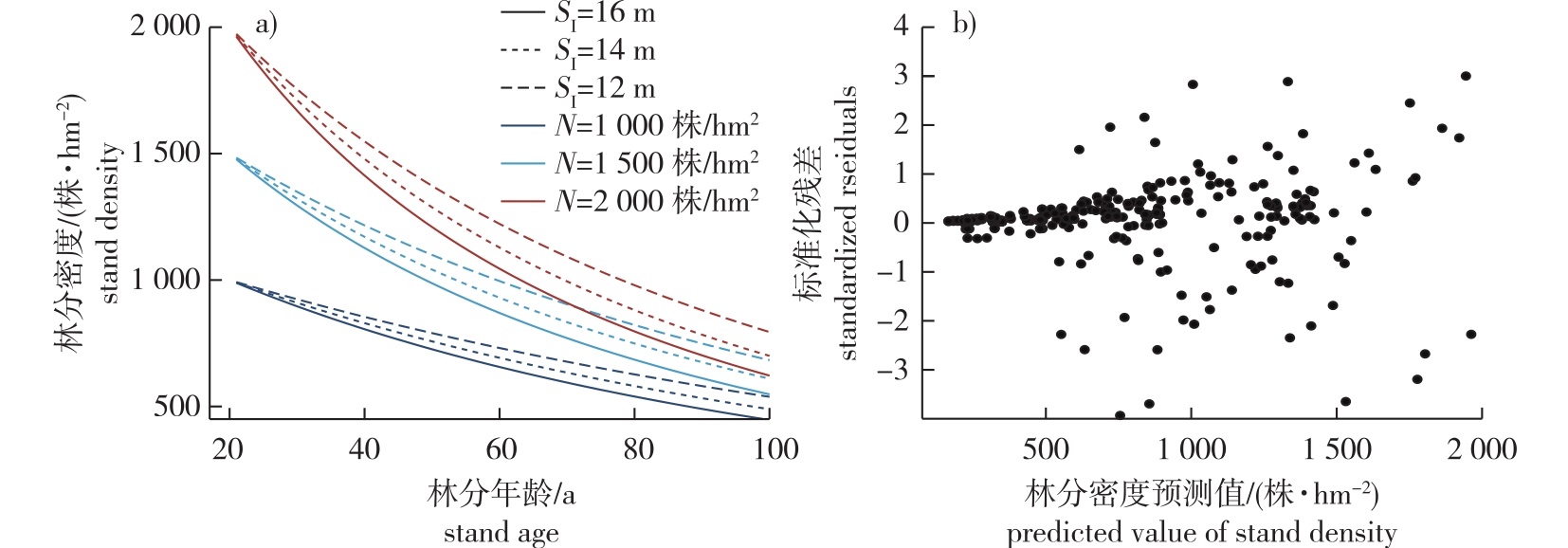 PDF(2366 KB)
PDF(2366 KB)


Stand-level growth model system with diameter class disaggregation for optimizing the management of Korean pine plantation
YANG Ruike, JIN Xingji, PUKKALA Timo, LI Fengri
Journal of Nanjing Forestry University (Natural Sciences Edition) ›› 2025, Vol. 49 ›› Issue (4) : 117-127.
 PDF(2366 KB)
PDF(2366 KB)
 PDF(2366 KB)
PDF(2366 KB)
Stand-level growth model system with diameter class disaggregation for optimizing the management of Korean pine plantation
【Objective】A system of stand-level growth models with diameter-class disaggregation was developed for Korean pine (Pinus koraiensis) plantations in Heilongjiang Province to optimize stand management strategies, providing model support for developing management schedules and enhancing forest quality.【Method】Based on the remeasurement data from 218 permanent plots in Korean pine plantations in Heilongjiang Province during 1980—2023, a model system consisting of models for mortality, dominant height, stand basal area and diameter-class disaggregation was constructed. The Weibull function was used to disaggregate the predictions over diameter classes. The parameters of the growth models were estimated using the Gauss-Newton method and seemingly unrelated regression. The method of moments was used to recover the diameter distribution parameters for the diameter-class disaggregation. To verify the applicability of the model system, the study used the differential evolution (DE) algorithm with a model system to perform stand-level management optimization to find the rotation length that maximized wood production in different site indices (11.2, 14.2, 16.0 m).【Result】The components of the dynamic growth model explained over 90% of the variation in the modelling data. The final critical errors for stand mortality and basal area model obtained using seemingly unrelated regression were 16.769% and 17.685%, respectively. When applying the method of moments for parameter estimation of the Weibull equation, the pass rate of the Kolmogorov-Smirnov test was 96.946%. When using the growth with diameter-class disaggregation for predicting stand volume, using an existing taper model, the critical error was 14.612%. The optimization results indicated that, for the three stands, the thinning is by 1-3 years later as site index improves by 2 m, with the final harvest age ranging from 72 to 75 years.【Conclusion】The growth model constructed in this study satisfies the basic assumptions of path-invariance, consistency, and causality during management simulations, thereby allowing reliable growth simulations. Integrating the model with the DE algorithm provides effective forest management prescriptions, offering useful advise for the management decisions of Korean pine plantations.

Pinus koraiensis (Korean pine) / stand growth model / difference equation / stand management decisions
| [1] |
姚予龙, 邵彬, 李泽红. “一带一路” 倡议下中俄林业合作格局与资源潜力研究[J]. 资源科学, 2018, 40(11):2153-2167.
|
| [2] |
梅梦媛, 雷一东. 我国人工林新时代发展形势分析[J]. 世界林业研究, 2019, 32(3):73-77.
|
| [3] |
|
| [4] |
徐颖, 蒋博, 金星姬, 等. 单木造材优化嵌入传统林分经营优化中的红松人工林精准经营模式[J]. 东北林业大学学报, 2024, 52(2):13-20.
|
| [5] |
|
| [6] |
|
| [7] |
|
| [8] |
|
| [9] |
|
| [10] |
|
| [11] |
|
| [12] |
|
| [13] |
|
| [14] |
|
| [15] |
|
| [16] |
郭泽鑫, 胡中岳, 曹聪, 等. 广东主要森林类型林分生物量和碳储量模型研建[J]. 林业科学, 2023, 59(12):37-50.
|
| [17] |
曾伟生, 孙乡楠, 王六如, 等. 东北林区10种主要森林类型的蓄积量、生物量和碳储量模型研建[J]. 北京林业大学学报, 2021, 43(3):1-8.
|
| [18] |
刘宁, 王彬, 郑淑霞, 等. 油松人工林相容性生长联立方程组模型构建[J]. 西南林业大学学报(自然科学), 2024, 44(2):119-126.
|
| [19] |
李际平, 郭文清, 曹小玉. 基于非线性度量误差的马尾松相容性立木生物量模型[J]. 中南林业科技大学学报, 2013, 33(6):22-25,32.
|
| [20] |
|
| [21] |
|
| [22] |
|
| [23] |
|
| [24] |
王鹤智. 东北林区林分生长动态模拟系统的研究[D]. 哈尔滨: 东北林业大学, 2012.
|
| [25] |
|
| [26] |
曹元帅, 孙玉军. 基于广义代数差分法的杉木人工林地位指数模型[J]. 南京林业大学学报(自然科学版), 2017, 41(5):79-84.
|
| [27] |
|
| [28] |
牛亦龙, 董利虎, 李凤日. 基于广义代数差分法的长白落叶松人工林地位指数模型[J]. 北京林业大学学报, 2020, 42(2):9-18.
|
| [29] |
李凤日. 测树学[M]. 5版. 北京: 中国林业出版社, 2024.
|
| [30] |
|
| [31] |
|
| [32] |
萨其拉. 黑龙江省典型人工针叶林直径分布模型[D]. 哈尔滨: 东北林业大学, 2023.
|
| [33] |
|
| [34] |
|
| [35] |
|
| [36] |
|
| [37] |
倪成才, 于福平, 张玉学, 等. 差分生长模型的应用分析与研究进展[J]. 北京林业大学学报, 2010, 32(4):284-292.
|
| [38] |
|
| [39] |
|
| [40] |
|
/
| 〈 |
|
〉 |